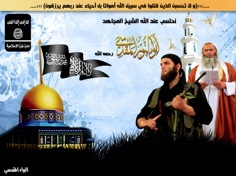
While participating in jihad gives a jihadist important religious credibility, death in battle provides immortality, as the deceased is ranked a martyr. It is believed that Muslim martyrs will be highly rewarded in the afterlife for their sacrifice and hold a special position in heavenly paradise. It is therefore not surprising that martyrdom is a central theme in jihadi visual propaganda.
This specific image is mourning the death of the spiritual leader of Jund Ansar Allah (JAA), ‘Abd al-Latif Musa Abu al-Nur al-Maqdisi (with the gray-white beard). Loosely following common Muslim funerary epigraphy, the inscription here opens at the top with Qur’anic text. Most often, the inscription will also include the name of the deceased and the date of death, and the inscription will often be paired with a shrine or other structure, as well as other elements in a traditional expression of death and mourning. The Qur’anic quote reads: (Q 3:169) “wa-la tahsabanna lladhina qutilu fi sabil Allah amwatan bal ahya’un ‘inda rabbihim yurzaqun” (“Do not consider those killed in the path of God dead, on the contrary, they are alive, being sustained by God”). Based on that text, as a mournful response, the caption underneath reads: “nahtasib ‘inda Allah al-shaykh al- mujahid Abu al-Nur al-Maqdisi, rahimahu Allah” (“we consider the mujahid (fighter) shaykh Abu al-Nur al-Maqdisi to be with God, may God have mercy on him”).
The logo at the top left is virtually identical to the familiar al-Qa’ida in Iraq/al-Qa’ida in the Arabian Peninsula logo, with the addition of the phrase “imarat ghaza al-islamiyya” (“the Islamic Emirate of Gaza”). This clearly expresses the group’s affiliation with (or at the very least identification with) the global jihadi movement.
More Information
The black banner hoisted on the Dome frequently appears in jihadist imagery. According to prophetic tradition (hadith), the black flag was the battle flag of the Prophet Muhammad and it was carried into battle by many of his companions. The image of the black flag has been used as a symbol of religious revolt and engagement in battle (i.e., jihad). In the contemporary Islamist movement, the black flag with the shahada (Islamic testimony of faith holding that there is no god but Allah and that Muhammad is his messenger) is used to evoke notions of jihad and of reestablishing the Islamic Caliphate.
The white birds flying around the minaret on the right taps into the world of birds, a very important motif in the symbolic language of Islam. Pre-Islamic Arabs imagined soul birds fluttering around the grave of the deceased, and the bird continues to symbolize the flight of the soul beyond the confines of this world. Doves in particular are considered sacred, since they are believed to have protected Muhammad during his nocturnal journey. It is in this manner that the dove can be linked to the notion of martyrdom and the rise of a martyr’s soul to heaven. The dove is also a symbol of loving fidelity, which is manifested by the collar of dark feathers around its neck, called “the dove’s necklace.”
 Skip to content
Skip to content
